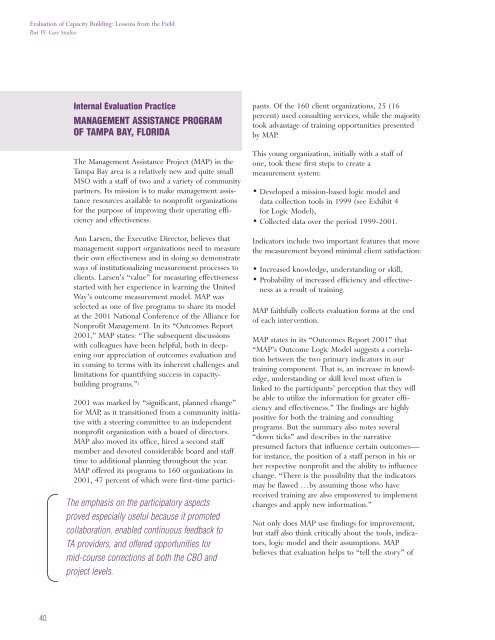Lessons from the Field - Seer Consulting
Lessons from the Field - Seer Consulting
Lessons from the Field - Seer Consulting
Create successful ePaper yourself
Turn your PDF publications into a flip-book with our unique Google optimized e-Paper software.
Evaluation of Capacity Building: <strong>Lessons</strong> <strong>from</strong> <strong>the</strong> <strong>Field</strong><br />
Part IV: Case Studies<br />
40<br />
Internal Evaluation Practice<br />
MANAGEMENT ASSISTANCE PROGRAM<br />
OF TAMPA BAY, FLORIDA<br />
The Management Assistance Project (MAP) in <strong>the</strong><br />
Tampa Bay area is a relatively new and quite small<br />
MSO with a staff of two and a variety of community<br />
partners. Its mission is to make management assistance<br />
resources available to nonprofit organizations<br />
for <strong>the</strong> purpose of improving <strong>the</strong>ir operating efficiency<br />
and effectiveness.<br />
Ann Larsen, <strong>the</strong> Executive Director, believes that<br />
management support organizations need to measure<br />
<strong>the</strong>ir own effectiveness and in doing so demonstrate<br />
ways of institutionalizing measurement processes to<br />
clients. Larsen’s “value” for measuring effectiveness<br />
started with her experience in learning <strong>the</strong> United<br />
Way’s outcome measurement model. MAP was<br />
selected as one of five programs to share its model<br />
at <strong>the</strong> 2001 National Conference of <strong>the</strong> Alliance for<br />
Nonprofit Management. In its “Outcomes Report<br />
2001,” MAP states: “The subsequent discussions<br />
with colleagues have been helpful, both in deepening<br />
our appreciation of outcomes evaluation and<br />
in coming to terms with its inherent challenges and<br />
limitations for quantifying success in capacitybuilding<br />
programs.” 1<br />
2001 was marked by “significant, planned change”<br />
for MAP, as it transitioned <strong>from</strong> a community initiative<br />
with a steering committee to an independent<br />
nonprofit organization with a board of directors.<br />
MAP also moved its office, hired a second staff<br />
member and devoted considerable board and staff<br />
time to additional planning throughout <strong>the</strong> year.<br />
MAP offered its programs to 160 organizations in<br />
2001, 47 percent of which were first-time partici-<br />
The emphasis on <strong>the</strong> participatory aspects<br />
proved especially useful because it promoted<br />
collaboration, enabled continuous feedback to<br />
TA providers, and offered opportunities for<br />
mid-course corrections at both <strong>the</strong> CBO and<br />
project levels.<br />
pants. Of <strong>the</strong> 160 client organizations, 25 (16<br />
percent) used consulting services, while <strong>the</strong> majority<br />
took advantage of training opportunities presented<br />
by MAP.<br />
This young organization, initially with a staff of<br />
one, took <strong>the</strong>se first steps to create a<br />
measurement system:<br />
• Developed a mission-based logic model and<br />
data collection tools in 1999 (see Exhibit 4<br />
for Logic Model),<br />
• Collected data over <strong>the</strong> period 1999-2001.<br />
Indicators include two important features that move<br />
<strong>the</strong> measurement beyond minimal client satisfaction:<br />
• Increased knowledge, understanding or skill,<br />
• Probability of increased efficiency and effectiveness<br />
as a result of training.<br />
MAP faithfully collects evaluation forms at <strong>the</strong> end<br />
of each intervention.<br />
MAP states in its “Outcomes Report 2001” that<br />
“MAP’s Outcome Logic Model suggests a correlation<br />
between <strong>the</strong> two primary indicators in our<br />
training component. That is, an increase in knowledge,<br />
understanding or skill level most often is<br />
linked to <strong>the</strong> participants’ perception that <strong>the</strong>y will<br />
be able to utilize <strong>the</strong> information for greater efficiency<br />
and effectiveness.” The findings are highly<br />
positive for both <strong>the</strong> training and consulting<br />
programs. But <strong>the</strong> summary also notes several<br />
“down ticks” and describes in <strong>the</strong> narrative<br />
presumed factors that influence certain outcomes—<br />
for instance, <strong>the</strong> position of a staff person in his or<br />
her respective nonprofit and <strong>the</strong> ability to influence<br />
change. “There is <strong>the</strong> possibility that <strong>the</strong> indicators<br />
may be flawed …by assuming those who have<br />
received training are also empowered to implement<br />
changes and apply new information.”<br />
Not only does MAP use findings for improvement,<br />
but staff also think critically about <strong>the</strong> tools, indicators,<br />
logic model and <strong>the</strong>ir assumptions. MAP<br />
believes that evaluation helps to “tell <strong>the</strong> story” of


